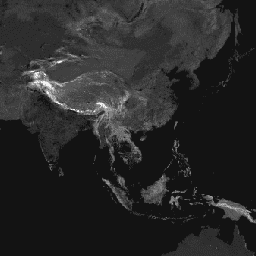
- 데이터 세트 사용 가능 기간
- 2019-01-01T00:00:00Z–2020-01-01T00:00:00Z
- 데이터 세트 제공업체
- Malaria Atlas Project
- 태그
설명
이 전역 마찰 표면은 명목상 2019년의 북위 85도와 남위 60도 사이의 모든 육지 픽셀에 대한 육상 이동 속도를 열거합니다. 또한 모터가 없는 교통수단만 사용하는 '도보 전용' 이동 속도도 포함됩니다. 이 지도는 MAP(옥스퍼드 대학교), Telethon Kids Institute(오스트레일리아 퍼스), Google, 트벤테 대학교(네덜란드)의 공동작업을 통해 제작되었습니다. 이 프로젝트는 Weiss et al 2018 (doi:10.1038/nature25181)에서 발표한 이전 작업을 기반으로 합니다. Weiss et al (2018)은 도로 (Open Street Map 및 Google 도로 데이터 세트의 최초 글로벌 규모 사용 포함), 철도, 강, 호수, 바다, 지형 조건 (경사 및 고도), 토지 피복 유형, 국경에 관한 데이터 세트를 활용했습니다. 이러한 데이터 세트에는 각 유형의 픽셀을 통과하는 데 걸리는 시간으로 표현된 이동 속도가 각각 할당되었습니다. 그런 다음 데이터 세트를 결합하여 '마찰 표면'을 생성했습니다. 이 지도는 각 픽셀에 해당 픽셀 내에서 발생하는 유형에 따라 명목상의 전체 이동 속도가 할당된 지도입니다. 현재 프로젝트의 경우 OSM 도로 데이터의 최근 개선사항을 통합하기 위해 업데이트된 마찰 표면이 생성되었습니다. 이 마찰 표면과 2015년 버전 (Weiss et al. 2018) 간의 차이가 반드시 인프라 (예: 새로운 도로 건설)의 변화를 나타내는 것은 아닙니다. 이러한 불일치는 데이터 품질 개선, 특히 OSM 도로 범위 업데이트와 관련이 있을 가능성이 훨씬 높습니다. 따라서 마찰 표면과 결과 이동 시간 지도 간의 비교는 신중하게 수행해야 하며 일반적으로 시간 경과에 따른 액세스 변화를 나타내는 것으로 해석해서는 안 됩니다. 이 지도는 이 할당 프로세스의 이동 속도를 나타내며, 1미터를 이동하는 데 필요한 시간(분)으로 표시됩니다. 이 데이터는 참조된 논문에 설명된 글로벌 의료 접근성 지도의 기본 데이터 세트를 구성합니다.
소스 데이터 세트 저작자 표시 정보는 동봉된 논문에 설명되어 있습니다.
대역
픽셀 크기
927.67미터
대역
| 이름 | 단위 | 최소 | 최대 | 픽셀 크기 | 설명 |
|---|---|---|---|---|---|
friction |
분/미터 | 0.000429 | 87.3075 | 미터 | 지상 이동 속도입니다. |
friction_walking_only |
분/미터 | 0.012 | 87.3075 | 미터 | 비동력 운송 수단을 사용한 육상 이동 속도입니다. |
이용약관
이용약관
이 작업물은 크리에이티브 커먼즈 저작자 표시 4.0 국제 라이선스에 따라 이용할 수 있습니다.
인용
D.J. Weiss, A. Nelson, C.A. Vargas-Ruiz, K. Gligorić, S. Bavadekar, E. Gabrilovich, A. Bertozzi-Villa, J. Rozier, H.S. Gibson, T. Shekel, C. Kamath, A. Lieber, K. Schulman, Y. Shao, V. Qarkaxhija, A.K. Nandi, S.H. Keddie, S. Rumisha, E. Cameron, K.E. Battle, S. Bhatt, P.W. Gething. 의료 시설까지의 이동 시간을 보여주는 전 세계 지도입니다. Nature Medicine (2020년).
Earth Engine으로 탐색하기
코드 편집기(JavaScript)
var dataset = ee.Image('Oxford/MAP/friction_surface_2019'); var landBasedTravelSpeed = dataset.select('friction'); var visParams = { min: 0.0022, max: 0.04, palette: [ '313695', '4575b4', '74add1', 'abd9e9', 'e0f3f8', 'ffffbf', 'fee090', 'fdae61', 'f46d43', 'd73027', 'a50026' ], }; Map.setCenter(43.55, 36.98, 4); Map.addLayer(landBasedTravelSpeed, visParams, 'Land-based travel speed');
